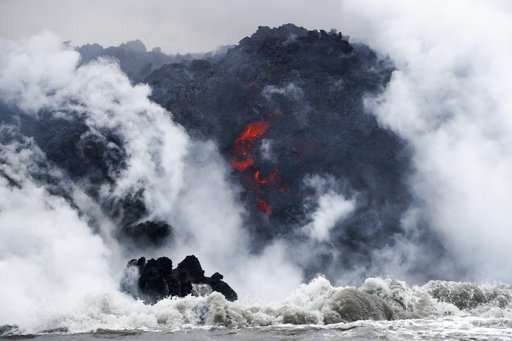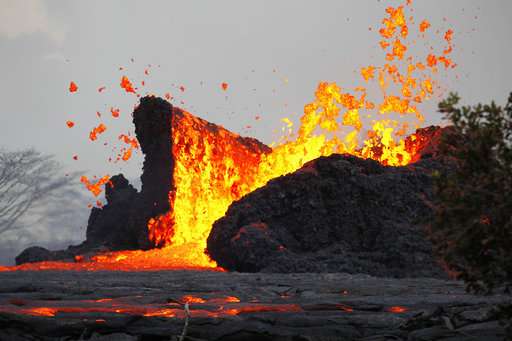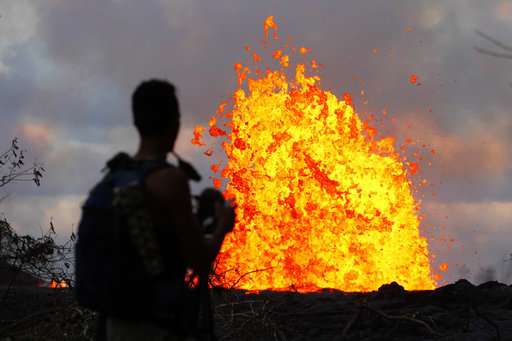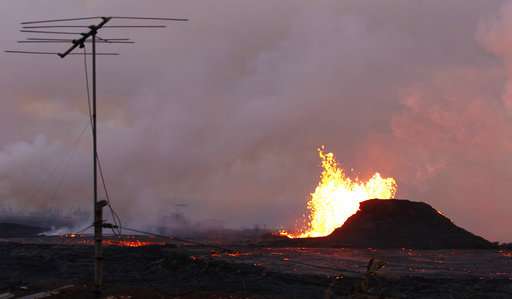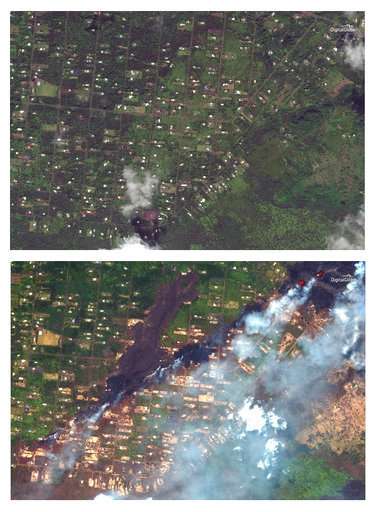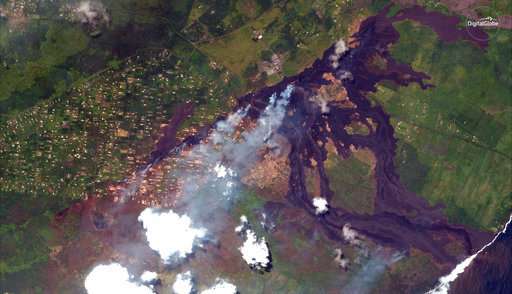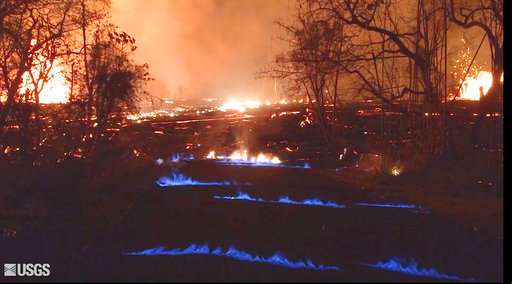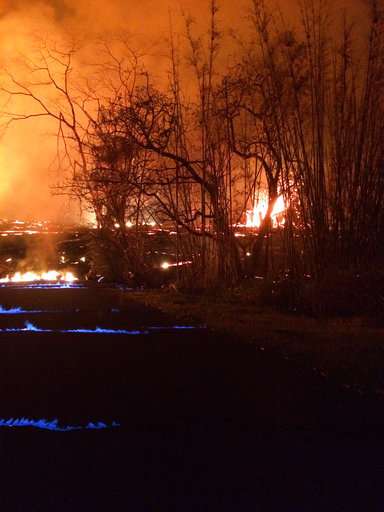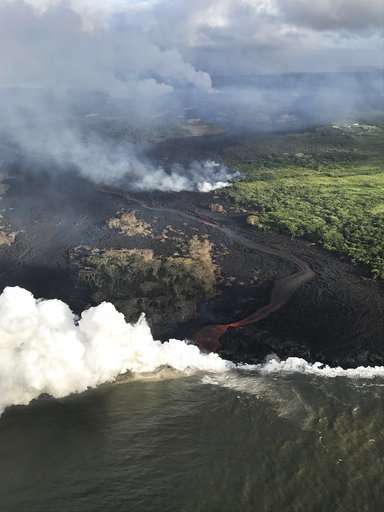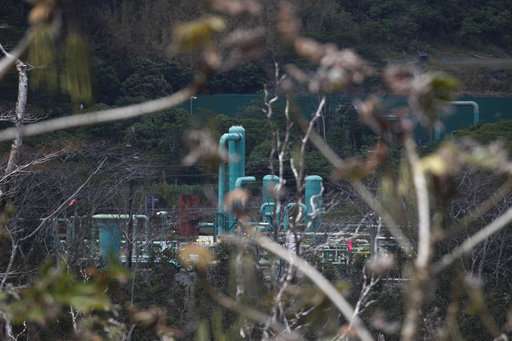In this May 20, 2018 file photo, lava flows into the ocean near Pahoa, Hawaii. (AP Photo/Jae C. Hong, File)
Lava entered the ocean from a third flow, marking the third week of a Hawaii volcano eruption that has opened up nearly two dozen vents in rural communities, destroyed dozens of buildings and shot miles-high plumes of ash into the sky.
Low lava fountains were erupting from a nearly continuous 2-mile-long (3.22-kilometer) portion of the series of fissures that have opened up in the ground, scientists said Thursday. The fountains were feeding channelized lava flows down to the coast. The eastern-most channel split, creating three ocean entries Wednesday.
Since the eruption began on May 3, Hawaii County has ordered about 2,000 people to evacuate from Leilani Estates and surrounding neighborhoods.
Hawaii officials have said they may need to evacuate a thousand more people if lava crosses key highways and isolates communities in the mostly rural part of the island where the Kilauea volcano is erupting.
A blocked highway would cut people off from the only route to grocery stores, schools and hospitals.
The U.S. Marine Corps said Thursday that it has sent two CH-53E Super Stallion helicopters from a base near Honolulu to help if more evacuations become necessary. Each helicopter can carry 50 passengers.
The volcano has opened more than 20 vents in the ground that have released lava, sulfur dioxide and steam. The lava has been pouring down the flank of the volcano and into the ocean miles away.
In this May 23, 2018 photo, lava erupts in the air in Leilani Estates area near Pahoa, Hawaii. The Kilauea volcano has opened more than 20 vents in the ground that have released lava, sulfur dioxide and steam. (George F. Lee/Honolulu Star-Advertiser via AP)
Lava has destroyed 50 buildings, including about two dozen homes. One person was seriously injured after being hit by a flying piece of lava.
There continues to be intermittent explosions at the summit that have been sending plumes of ash into the sky. On Wednesday, the volcano belched a plume that reached about 7,000 feet (2,133 meters), scientists said. Right before the explosion, there was a 3.9 magnitude earthquake at the summit.
"We are kind of in this steady state," said Wendy Stovall, a scientist at the U.S. Geographical Survey. There's no indication about whether lava volume will increase or decrease, she said. The continued explosions are expected to "last a little while longer."
-
In this May 23, 2018 photo, lava erupts in the air in Leilani Estates area near Pahoa, Hawaii. The Kilauea volcano has opened more than 20 vents in the ground that have released lava, sulfur dioxide and steam. (George F. Lee/Honolulu Star-Advertiser via AP)
-
In this May 23, 2018 photo, lava erupts in the air in Leilani Estates area near Pahoa, Hawaii. The Kilauea volcano has opened more than 20 vents in the ground that have released lava, sulfur dioxide and steam. (George F. Lee/Honolulu Star-Advertiser via AP)
-
This combination of satellite images provided by DigitalGlobe shows a southeast area of the Leilani Estates neighborhood, near Pahoa, Hawaii, May 24, 2017, top, and May 23, 2018, bottom, after recent Kilauea volcanic activities. (Satellite Image ©2018 DigitalGlobe, a Maxar company via AP)
-
This May 23, 2018, Satellite photo provided by DigitalGlobe shows lava coming out of fissures caused by Kilauea volcano, running towards the Puna coast, lower right, along Malama Ki Forest Reserve recreation area in Pahoa, Hawaii. Puna Geothermal Venture, a geothermal energy plant is seen at upper middle. The Leilani Estates neighborhood, where the volcano has been gushing lava on the big island of Hawaii for the past three weeks, is seen at center left part. (Satellite Image ©2018 DigitalGlobe, a Maxar company via AP)
-
This photo from video from the U.S. Geological Survey shows blue burning flames of methane gas erupting through cracks on Kahukai Street in the Leilani Estates neighborhood of Pahoa on the island of Hawaii during the overnight hours of Wednesday, May 23, 2018. When lava buries plants and shrubs, methane gas is produced as a byproduct of burning vegetation. Methane gas can seep into subsurface voids and explode when heated, emerging from cracks in the ground several feet away from the lava. (U.S. Geological Survey via AP)
-
This photo released Wednesday, May 23, 2018 by the U.S. Geological Survey shows blue burning flame of methane gas was observed in the cracks on Kahukai Street, during the overnight hours. The volcano produces methane when hot lava buries and burns plants and trees. Scientists say the methane can seep through cracks several feet away from the lava. ( U.S. Geological Survey via AP)
-
This Wednesday, May 23, 2018, photo provided by the U.S. Geological Survey, the active fissure complex in Kilauea Volcano's lower East Rift Zone near Pahoa, Hawaii. The volcano produces methane when hot lava buries and burns plants and trees. Scientists say the methane can seep through cracks several feet away from the lava. ( U.S. Geological Survey via AP)
-
A a geothermal plant is seen from the Leilani Estates subdivision near Pahoa, Hawaii, Tuesday, May 22, 2018. Authorities were racing Tuesday to close off production wells at the plant threatened by a lava flow from Kilauea volcano on Hawaii's Big Island. (AP Photo/Jae C. Hong)
© 2018 The Associated Press. All rights reserved.
